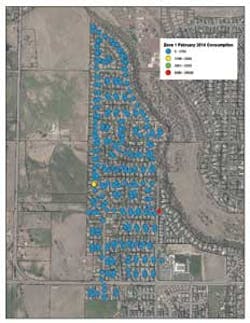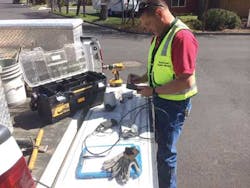From Reactive to Proactive: Big Data Prevents Big Problems in Redmond, Ore.
AMI solution helps city locate non-revenue leaks, improve model accuracy, detect theft or damage, cut revenue loss, and forecast future usage.
By Steve Bruskiewicz
Considered the geographical heart of central Oregon, the city of Redmond lies east of the Cascade Mountains. It is an outdoor paradise with ample rock-climbing destinations including renowned Smith Rock, as well as some of the best trout fishing in the world on the Crooked, Deschutes and Metolius rivers.
For 20 years, the town's population grew right along with most of Deschutes County, expanding by 74% between 2000 and 2006, making it one of the state's fastest growing incorporated cities. Fueled by employment, comparatively low cost of living and great quality of life, Redmond's population is currently over 26,000 residents.
The city operates and maintains a water distribution infrastructure that incorporates a series of pumps, wells and reservoirs serving approximately 10,000 accounts along 164 miles of pipe. The wells pump water directly into the main distribution system to satisfy demand first. Excess water is redirected into reservoirs.
The irrigation season runs from April through October. To fulfill the demand for water in the summer, the pumps produce about 11.5 million gallons a day (MGD). During winter, usage drops considerably to an average of 2 MGD. Although irrigation is prohibited from November to March, during this period residents are still free to water shrubs and gardens.
"This downtime offers us an opportunity to review monthly water consumption reports based on code classifications and analyze system efficiencies and demand trends," said Josh Wedding, water operations manager with Redmond. "It also gives us a chance to analyze and compile the data."
Critical Factors Demand Automation
Redmond first looked to advanced metering infrastructure (AMI) to improve customer service. It was difficult to understand why a customer's bill was high or answer questions about usage patterns based on a single meter read per month.
"Moving to AMI has been an evolution for us," said Wedding. "This was new technology to us and the industry. First and foremost we wanted to provide better customer service through improved communication with customers regarding concerns with billing, leaks and responsible water use. It gave us a valuable tool to coordinate our water conservation programs."
As a result, in 2006, the city installed Aclara's STAR Network technology to provide an automated meter reading solution. The system includes 15 data collectors that redundantly collect readings from meter transmitters on residential, commercial and industrial water meters. The redundancy of the system ensures that the city seldom, if ever, misses a reading. Further, the AMI system provided readings four times per day, giving the utility more information to answer customer questions and quickly identify problems such as leaks on premises and meter inefficiencies.
In 2012, Redmond began installing Aclara's Series 3000 two-way, fixed network AMI, which provides daily, time- synchronized meter readings at the top of the hour that allow the city to cross-reference other data, such as the irrigation system clock, to provide a better understanding of whether water being pumped into the individual irrigation zones across Redmond is being metered. This helps the city identify leaks and non-revenue water losses more efficiently.
"It's nice to get reads at the top of the hour," said Wedding, "because we can line up demand with production hour for hour, especially during the peak demand periods."
The city also now imports additional information, such as cycle, route, billing account status (active or inactive), and billing and class codes (residential, commercial or industrial) from its customer information system (CIS) into Aclara's STAR Network database. This allows the development of reports to help further understand the water system. With the additional information coming in from CIS, for instance, Redmond can run a report to identify whether there are inactive accounts using water.
Wedding explained that when Redmond's "snowbirds" fly south, they typically put their accounts into inactive status, although the water remains on. "If we see a large amount of water flow based on meter readings, we can send a field crew out to determine whether there's a leak and then shut off the water."
Identify Problems Faster
With its updated AMI system, the utility can capture an eight-digit meter reading instead of a six-digit one. Why is this important? The higher-resolution readings allow the utility to more quickly identify areas where smaller leaks may be occurring. If a meter only has a resolution of 50 cubic feet per hour, for example, leaks that are smaller will not be detected immediately. What's more, Redmond can take full advantage of Aclara's MTUs by reprogramming them to adjust readings down to one-tenth of a cubic foot. Such a minute measurement can detect a leak of seven gallons per minute.
With AMI, Redmond can easily explain high water bills, locate non-revenue leaks, improve upon water model accuracy, detect theft or damage, minimize revenue loss, determine active or inactive billing status, and forecast future usage.
"We can use AMI data to transition from reactive to proactive mode," said Wedding. "When we see customers losing water, we can dispatch a tech with a smart phone, send customer email alerts, hang door tags, or make phone calls," he said. "We're always finding new reasons to like AMI."
Because Redmond has a large number of accounts like warehouses, commercial properties and residential rentals that move from active to inactive for an extended period of time, the utility uses AMI-generated data to alert property owners of water usage, leaks or damaged pipes on vacant accounts that could result in property damage. Landlords can then shut off water and make any necessary repairs based on information that normally wouldn't surface until the end of a billing cycle.
Spotting Broken Meters
Anyone who works for a water utility knows that registers and meters can malfunction and stop registering usage. However, most utilities aren't alerted to these failures until reports are generated for billing, allowing a broken meter or register to be deployed for as long as two billing cycles. But Redmond now runs an automatic weekly report on active accounts not using water to identify meters with broken measuring chambers.
Using active and inactive billing status to identify and repair broken meters and minimize lost revenue from unaccounted-for water is mission critical. The real challenge for and benefit to the utility is shrinking the time between when the damage occurs and when repairs are made to restore the ability to calculate water usage.
"This analytic comes in handy year-round, but it's particularly important during inclement weather like a deep freeze in winter," Wedding said. "More than 90% of our meters are residential - we repair about 30 meters on average and as many as 120 a week, based on running reports."
GIS = Coding and Conservation
Redmond has transferred and used Aclara's data in its geographical information system (GIS) to augment color-coded maps that show average residential water use citywide. "We generated maps for conservation purposes and to get a better idea of responsible water use around town," said Wedding.
Mapping can quickly identify accounts that potentially pose a serious problem in terms of leaks or damage. Since all accounts in GIS are updated daily with Aclara's data, the utility can easily map and cross-reference accounts appearing to have a problem.
Redmond partnered with a consulting firm to create water models using AMI data that are based on three classification codes: residential, commercial and industrial. Because all of Redmond's meters are mapped using survey-grade GPS, loading class codes into GIS not only provides maps showing high water use from the heaviest users during non-irrigation months but also assists the utility with proper placement of future wells or booster stations. "We can identify monthly residential demands and anticipate future consumption at new property developments that will house medical facilities or industrial parks," said Wedding. "This kind of planning helps us relieve burdens on the system."
Looking to the Future
Redmond aims to implement a consumer engagement tool that will empower consumers with easy-to-read, daily charts and graphs of meter data, helping them identify leaks or high and low periods of water consumption. "With direct access to this information, customers can become more informed stewards of their resources," said Wedding.
About the Author: Steve Bruskiewicz is a product manager in the marketing department at Aclara Technologies and has been providing solutions for the water industry for more than 30 years.



